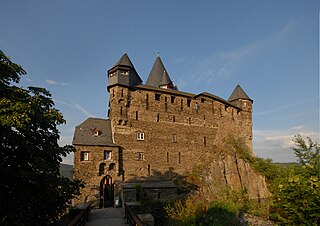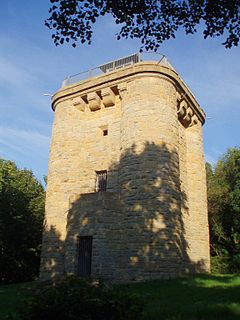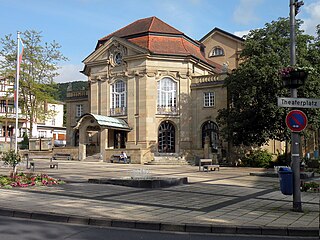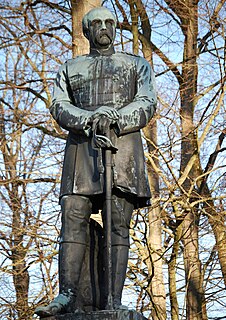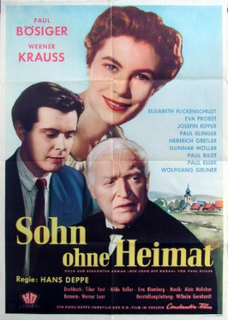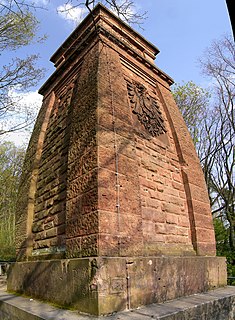
The construction of the Bismarck Tower located on the "Sinnberg", a hill in the German spa town of Bad Kissingen, started in 1914 following the plans designed by architect, Wilhelm Kreis. It was projected by the local Bismarck Tower Association under the chairmanship of its founder, pharmacist Oscar Ihl. This association was in favour of Bismarck and the German Empire and competed in a certain way with the Wittelsbacher Association, which, even after the Unification of Germany, regarded the Kingdom of Bavaria to be a sovereign kingdom and built the Wittelsbacher Tower in Bad Kissingen in 1907. [1]

Bad Kissingen is a spa town in the Bavarian region of Lower Franconia and seat of the district Bad Kissingen. Situated to the south of the Rhön Mountains on the Franconian Saale river, it is one of the health resorts, which became famous as a "Weltbad" in the 19th century.

Wilhelm Kreis was a prominent German architect and professor of architecture, active through four political systems in German history: the Wilhelmine era, the Weimar Republic, the Third Reich, and the foundation of the Federal Republic.

The German Empire, also known as Imperial Germany, was the German nation state that existed from the unification of Germany in 1871 until the abdication of Kaiser Wilhelm II in 1918.
Contents
Up to that time, the architect of the Bismarck Tower, Wilhelm Kreis, had already designed different Bismarck Towers; his concept "Götterdämmerung" was carried out in 47 towers alone, which differed only slightly from each other. The construction of the Bismarck Tower in Bad Kissingen, however, followed a completely new design.
Due to the outbreak of World War I, a delay in finishing the construction took place. It was only on 2 December 1926 that, under the promotion of the "Movement for Completing the Tower" under the chairmanship of Wolfgang Singer, the director of the spa gardens, that the roofing ceremony could be held. [2] The completion of the tower's exterior was delayed until 1930 due to the Great Depression. In 1934, Wolfgang Singer conveyed the construction of a hairpin-bended footway leading to the Bismarck Tower.

World War I, also known as the First World War or the Great War, was a global war originating in Europe that lasted from 28 July 1914 to 11 November 1918. Contemporaneously described as "the war to end all wars", it led to the mobilisation of more than 70 million military personnel, including 60 million Europeans, making it one of the largest wars in history. It is also one of the deadliest conflicts in history, with an estimated nine million combatants and seven million civilian deaths as a direct result of the war, while resulting genocides and the 1918 influenza pandemic caused another 50 to 100 million deaths worldwide.

The Great Depression was a severe worldwide economic depression that took place mostly during the 1930s, beginning in the United States. The timing of the Great Depression varied across nations; in most countries it started in 1929 and lasted until the late-1930s. It was the longest, deepest, and most widespread depression of the 20th century. In the 21st century, the Great Depression is commonly used as an example of how intensely the world's economy can decline.
During World War II, the Bismarck Tower was used as an observation point for observing the airspace. [2] It was only in 1985 that the construction of the tower's interior was started. So, the tower could be opened to the public on 21 June 1986. [2] A staircase, bathrooms, and an observation deck were built into the tower.

World War II, also known as the Second World War, was a global war that lasted from 1939 to 1945. The vast majority of the world's countries—including all the great powers—eventually formed two opposing military alliances: the Allies and the Axis. A state of total war emerged, directly involving more than 100 million people from over 30 countries. The major participants threw their entire economic, industrial, and scientific capabilities behind the war effort, blurring the distinction between civilian and military resources. World War II was the deadliest conflict in human history, marked by 50 to 85 million fatalities, most of whom were civilians in the Soviet Union and China. It included massacres, the genocide of the Holocaust, strategic bombing, premeditated death from starvation and disease, and the only use of nuclear weapons in war.
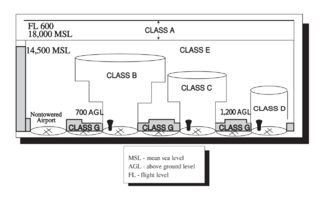
Airspace is the portion of the atmosphere controlled by a country above its territory, including its territorial waters or, more generally, any specific three-dimensional portion of the atmosphere. It is not the same as aerospace, which is the general term for Earth's atmosphere and the outer space in its vicinity.








